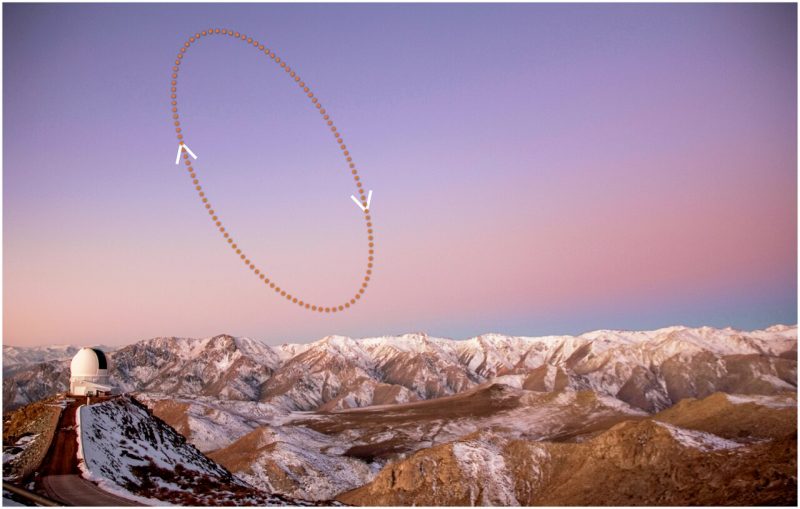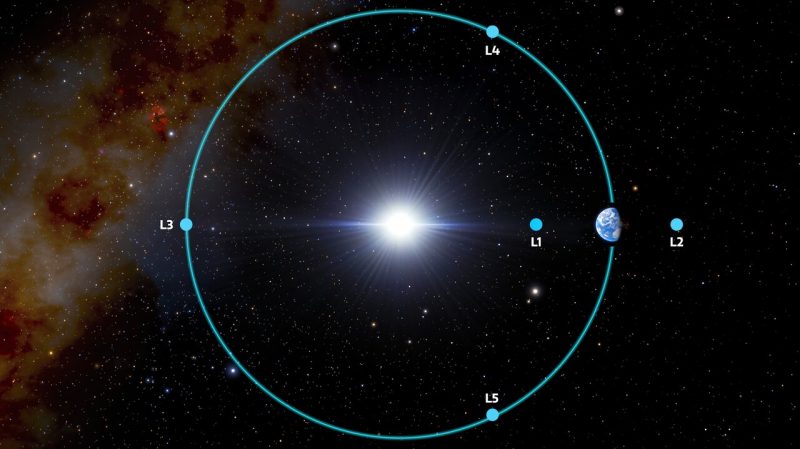
A 2nd Trojan asteroid for Earth
Remember the excitement in late January, when the James Webb Space Telescope reached Lagrange point 2, or L2? That’s a gravitationally stable point in the Earth-sun system where a spacecraft (or a natural object) can orbit the sun while maintaining its position relative to the sun and Earth. There are five Lagrange points. Two of these points – L4 and L5 – are on Earth’s orbit around the sun. Asteroids located at the Earth-leading Lagrange point (L4) and the Earth-trailing Lagrange point (L5) are known to astronomers as Trojan asteroids or Earth Trojans. Astronomers already knew Earth had one Trojan. Now we know it has two, with the second announced on February 1, 2022. This new Earth Trojan has been labeled 2020 XL5.
The peer-reviewed journal Nature Communications published the new findings about 2020 XL5 on February 1.
Discovering the Trojan asteroid
Astronomers first discovered this new object on December 12, 2020, using the Pan-STARRS1 survey telescope in Hawaii. Without much data to go on, scientists couldn’t say if its orbit was simply intersecting ours, or if it was a true Trojan asteroid. The first Trojan asteroids – and still our solar system’s largest known population of Trojan asteroids – lead or follow Jupiter in orbit. Jupiter has more than 7,000 Jupiter Trojans. That makes sense, because Jupiter is our solar system’s most massive planet. Its gravity would naturally pull more asteroids toward itself than, for example, Earth’s much-weaker gravity.
That’s why, until now, Earth only had one known Trojan asteroid. 2020 XL5 is nearly three times larger than Earth’s other known Trojan.
The 2022 lunar calendars are still available. Order yours before they’re gone!

More Trojan asteroids
We mentioned the giant planet Jupiter has the largest population of Trojan asteroids in our solar system. More than 7,000 are cataloged, but, if astronomers could find them all, we’d probably learn that Jupiter is home to more than a million Trojans larger than 1/2 mile (one kilometer) in diameter.
Meanwhile, Neptune has 28 identified Trojans. Uranus is known to have two. Little Mars – one step outward from Earth – has nine known Trojan asteroids. Venus has only one temporary Trojan asteroid that we know so far.
The newly found Earth Trojan is more than 1/2 mile (1 kilometer) in size. Contrast its size to the first-known Earth Trojan, labeled 2010 TK7. It’s less than 1,300 feet (400 meters) across.
After finding the asteroid in 2020, scientists searched through old data from the Dark Energy Survey from 2012 to 2019 to find more images. But the new results from SOAR are the ones that clinched the identification. The scientists say 2020 XL5 is a C-type asteroid: It’s the most common type of asteroid, which is dark and carbon-rich. Lead author Toni Santana-Ros of the University of Alicante and the Institute of Cosmos Sciences of the University of Barcelona said in a statement:
SOAR’s data allowed us to make a first photometric analysis of the object, revealing that 2020 XL5 is likely a C-type asteroid, with a size larger than one kilometer [1/2 mile].
In a stable orbit, for now
Asteroid 2020 XL5 is in a stable orbit, at the moment, at the sun-Earth Lagrange point 4. It orbits the sun at the same distance as Earth, leading Earth in our 365-day orbit around the sun. The other known Earth Trojan asteroid, 2010 TK7, also orbits at the Earth-leading Lagrange point 4, or L4.
Studies by astronomers show, however, that 2020 XL5 will only be in this stable orbit for a number of thousand years. L4 is relatively stable gravitationally, but it’s not infinitely stable. The astronomers who studied it said that perturbations – minor gravitational pulls from objects other than the Earth and sun – will ultimately fling the little asteroid out of L4. That’ll happen in about 4,000 years. Cut loose from L4 and from the bonds of Earth’s gravity, it’ll then continue on its way, to wander through the space of our solar system … like the millions of other large and small bodies that reside in our sun’s family.
Earth Trojans are hard to spot
So we now know of two Earth Trojans. And there might be more out there, moving at L4 and L5 in the Earth-sun system, unbeknownst to us (for now). Trojan asteroids are hard to spot. They tend to be small and therefore dim. If they weren’t so small and dim, we might have seen them already. But the biggest stumbling block is that these asteroids always appear close to the sun in our sky. You know how Venus passed between us and the sun last month, and – in February 2022 – is racing ahead of Earth in its smaller orbit? And, if you’ve looked, you know how we see Venus very near the sunrise horizon now? Earth Trojans at L4 are similar to Venus in that they’re moving ahead of us in orbit and reside near the sunrise.
And indeed telescopes searching for Earth Trojans must look toward the horizon before sunrise or after sunset, to see objects leading us or trailing us in orbit. As always, as we peer toward the horizon, we’re looking toward a thicker blanket of Earth’s atmosphere than when we look overhead. The SOAR telescope pointed just 16 degrees from the horizon to find 2020 XL5. Stretch your hand to the horizon and extend your index finger and pinky: the distance between them on the sky’s dome is about 15 degrees.
Co-author Cesar Briceño of NOIRLab said:
These were very challenging observations, requiring the telescope to track correctly at its lowest elevation limit, as the object was very low on the horizon at dawn.

Earth Trojans are intriguing
But finding more Earth Trojans could be important in the future. As Briceño said:
If we are able to discover more Earth Trojans, and if some of them can have orbits with lower inclinations, they might become cheaper to reach than our moon. So they might become ideal bases for an advanced exploration of the solar system, or they could even be a source of resources.
Bottom line: Scientists have confirmed the existence of the second-known Earth Trojan asteroid. It is three times as large as the first discovered one.
The post Astronomers confirm a 2nd Trojan asteroid for Earth first appeared on EarthSky.
0 Commentaires